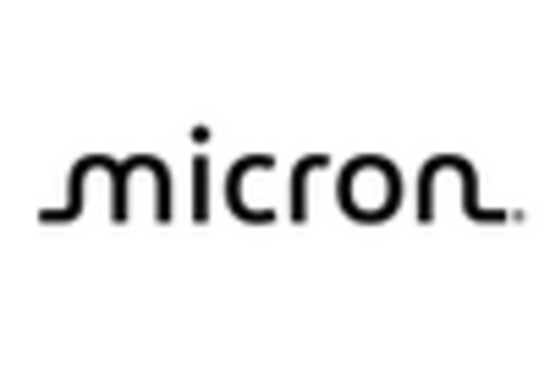Rise of Electric Vehicles
The Advanced Materials for Semiconductor Market is significantly influenced by the rise of electric vehicles (EVs). As the automotive sector transitions towards electrification, the demand for advanced semiconductor materials is expected to increase substantially. The EV market is projected to grow at a compound annual growth rate (CAGR) of 22% from 2025 to 2030, necessitating the development of high-performance semiconductors. Advanced materials such as silicon carbide (SiC) and gallium nitride (GaN) are pivotal in enhancing the efficiency and performance of power electronics in EVs. This shift not only propels the Advanced Materials for Semiconductor Market but also aligns with global sustainability goals, as EVs contribute to reduced carbon emissions.
Growing Demand for Miniaturization
The Advanced Materials for Semiconductor Market is experiencing a notable surge in demand driven by the trend towards miniaturization in electronic devices. As consumer electronics evolve, manufacturers are increasingly seeking materials that enable smaller, more efficient components. This trend is reflected in the semiconductor industry, where the market for miniaturized chips is projected to reach USD 500 billion by 2026. Advanced materials such as high-k dielectrics and low-k interlayer dielectrics are essential in achieving the desired performance while reducing size. The push for miniaturization not only enhances device portability but also improves energy efficiency, thereby driving the growth of the Advanced Materials for Semiconductor Market.
Growing Internet of Things Applications
The proliferation of Internet of Things (IoT) applications is driving demand within the Advanced Materials for Semiconductor Market. As IoT devices become increasingly ubiquitous, the need for advanced semiconductor materials that can support connectivity and data processing is paramount. The IoT market is projected to grow to USD 1 trillion by 2026, creating a substantial opportunity for semiconductor manufacturers. Advanced materials such as flexible substrates and high-performance polymers are essential for developing IoT devices that are both efficient and reliable. This trend not only enhances the functionality of IoT applications but also propels the growth of the Advanced Materials for Semiconductor Market.
Increased Investment in Research and Development
Increased investment in research and development (R&D) is a significant driver for the Advanced Materials for Semiconductor Market. Companies are allocating substantial resources to explore new materials and processes that can enhance semiconductor performance. The global semiconductor R&D expenditure is expected to exceed USD 70 billion by 2025, reflecting a commitment to innovation. This investment is crucial for developing advanced materials that can meet the evolving demands of various applications, including artificial intelligence and 5G technology. As the industry seeks to push the boundaries of performance, the Advanced Materials for Semiconductor Market stands to benefit from these R&D initiatives.
Technological Advancements in Semiconductor Manufacturing
Technological advancements in semiconductor manufacturing processes are a key driver for the Advanced Materials for Semiconductor Market. Innovations such as extreme ultraviolet (EUV) lithography and atomic layer deposition (ALD) are enabling the production of smaller and more complex semiconductor devices. These technologies require advanced materials that can withstand the rigorous demands of modern fabrication techniques. The semiconductor manufacturing sector is projected to invest over USD 200 billion in new technologies by 2027, further propelling the need for advanced materials. As manufacturers strive for higher yields and lower defect rates, the Advanced Materials for Semiconductor Market is poised for substantial growth.















Leave a Comment